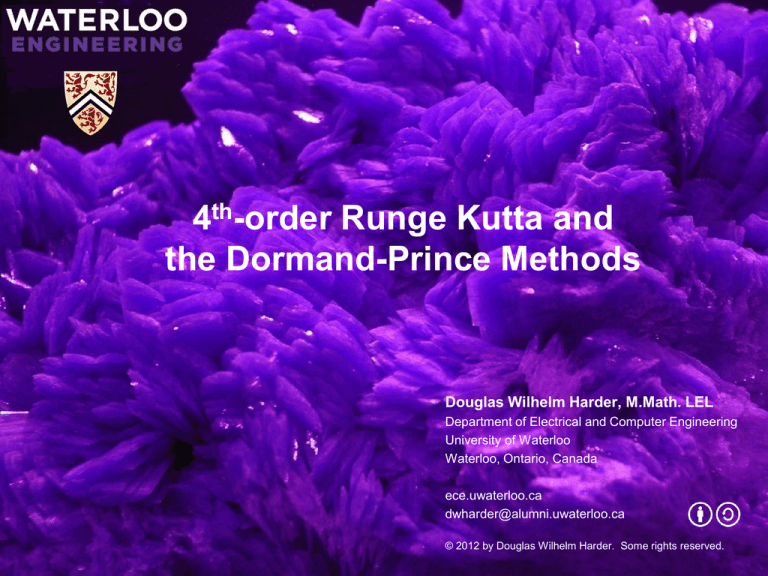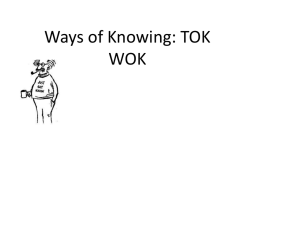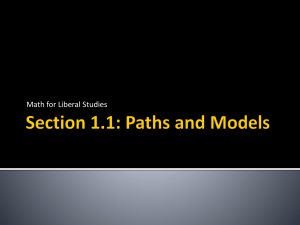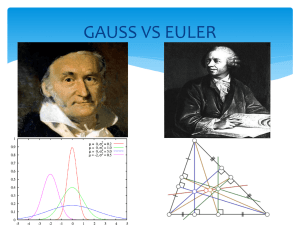
4th-order Runge Kutta and
the Dormand-Prince Methods
Douglas Wilhelm Harder, M.Math. LEL
Department of Electrical and Computer Engineering
University of Waterloo
Waterloo, Ontario, Canada
ece.uwaterloo.ca
dwharder@alumni.uwaterloo.ca
© 2012 by Douglas Wilhelm Harder. Some rights reserved.
4th-order Runge Kutta and the Dormand-Prince Methods
Outline
This topic discusses advanced numerical solutions to
initial value problems:
–
–
–
–
–
Weighted averages and integration techniques
Runge-Kutta methods
4th-order Runge Kutta
Adaptive methods
The Dormand-Prince method
• The Matlab ode45 function
2
4th-order Runge Kutta and the Dormand-Prince Methods
Outcomes Based Learning Objectives
By the end of this laboratory, you will:
– Understand the 4th-order Runge-Kutta method
– Comprehend why adaptive methods are required to reduce the
error but also reduce the effort
– Understand the algorithm for the Dormand-Prince method
3
4th-order Runge Kutta and the Dormand-Prince Methods
4
Weighted Averages
The average of five numbers x1, x2, x3, x4, and x5 is:
x
x1 x 2 x 3 x 4 x 5
5
1
5
x1
1
5
x2
1
5
x3
1
5
x4
1
5
x5
Suppose these were project grades and the last two
projects had twice the weight of the other projects
– We can calculate the following weighted average:
1
7
x1
1
7
x2
1
7
x3
2
7
x4
2
7
x5
4th-order Runge Kutta and the Dormand-Prince Methods
5
Weighted Averages
In fact, any combination scalars of a1, a2, a3, a4, and a5
such that
a1 a 2 a 3 a 4 a 5 1
allows us to calculate the weighted average
a1 x1 a 2 x 2 a 3 x 3 a 4 x 4 a 5 x 5
It is also possible to have negative weights:
1
3
1
3
x1
1
3
1
3
x2
1
3
1
3
1
3
x3
1
3
1
3
1
x 4 13 x 5
Richardson extrapolation weights:
4
3
1
3
1,
16
15
1
15
1
4th-order Runge Kutta and the Dormand-Prince Methods
Integration
We will motivate this next idea by looking at
approximating integrals
b
– We wish to approximate
f x d x
a
6
4th-order Runge Kutta and the Dormand-Prince Methods
7
Integration
In first year, you would have seen the approximation:
– Approximate the integral by calculating the area of the square
b
f x dx f x x
1
2
x1
a
a=
=b
4th-order Runge Kutta and the Dormand-Prince Methods
8
Integration
Alternatively, you could use the mid-point:
b
f x dx f x x
2
3
x1
a
a=
=b
4th-order Runge Kutta and the Dormand-Prince Methods
9
Integration
Or, take a weighted average of the two end points
– This weighted average calculates the area of the trapezoid
b
a
1
1
f x dx f x1 f x 2 x 2 x1
2
2
The trapezoidal rule
a=
=b
4th-order Runge Kutta and the Dormand-Prince Methods
10
Integration
We could take a weighted average of three points
– This calculates the area of two trapezoids
b
a
1
1
1
f x dx f x1 f x 2 f x 3 x 3 x1
2
4
4
The composite
trapezoidal rule
a=
=b
4th-order Runge Kutta and the Dormand-Prince Methods
11
Integration
A better approximation is to give more weight to the mid
point
– This calculates the area under the interpolating quadratic
function
b
a
2
1
1
f x dx f x1 f x 2 f x 3 x 3 x1
3
6
6
Simpson’s rule
a=
=b
4th-order Runge Kutta and the Dormand-Prince Methods
12
Integration
We can increase the number of points and use other
weights
– This calculates the area under the interpolating quadratic
function
b
f
x
f
x
f
x
f
x
x
dx
8
x
8
8
8
f
1
3
1
3
2
1
3
4
4
x1
a
Simpson’s 3/8 rule
a=
=b
4th-order Runge Kutta and the Dormand-Prince Methods
Initial-value Problems
We will use the same weighted average idea to find
better approximations of an initial-value problem
In the last laboratory, we saw
– Euler’s method
– Heun’s method
In this laboratory, we will see:
– The 4th-order Runge Kutta method
– The Dormand-Prince method
Both use weighted averages
13
4th-order Runge Kutta and the Dormand-Prince Methods
Initial-value Problems
Recall that given a 1st-order ordinary-differential equation
and an initial condition
y
1
t
f t, y t
Then, given an initial condition
y t0 y0
we would like to approximate a solution
14
4th-order Runge Kutta and the Dormand-Prince Methods
Initial-value Problems
For example, consider
y
1
t y t 2 t t t 1
y 0 1
15
4th-order Runge Kutta and the Dormand-Prince Methods
Initial-value Problems
For example, consider
y
1
t y t 2 t t t 1
y 0 1
16
4th-order Runge Kutta and the Dormand-Prince Methods
Euler’s Method
Euler’s method approximates the slope by taking one
sample: K 1 f t k , y k
This slope is then used to approximate the next point:
y k 1 y k hK 1
17
4th-order Runge Kutta and the Dormand-Prince Methods
Euler’s Method
In our example, if h = 0.5, we would calculate this slope
y
1
t y t 2 t t t 1
y 0 1
18
4th-order Runge Kutta and the Dormand-Prince Methods
19
Euler’s Method
We follow this slope a distance h = 0.5 out:
y
1
t y t 2 t t t 1
y 0 1
y 0.5 y1 y 0 0.5 1
1 0.5 0.5
4th-order Runge Kutta and the Dormand-Prince Methods
Euler’s Method
The approximation is not great if h is too large:
y
1
t y t 2 t t t 1
y 0 1
20
4th-order Runge Kutta and the Dormand-Prince Methods
Heun’s Method
Heun’s method approximates the slope by taking two
samples:
K f t , y
1
k
k
K 2 f t k h , y k hK 1
The average of the two slopes is used to approximate
the next point:
y k 1 y k h
K1 K 2
2
21
4th-order Runge Kutta and the Dormand-Prince Methods
22
Heun’s Method
For Heun’s method, we calculate a second slope:
y
1
t y t 2 t t t 1
y 0 1
K1 1
K 2 f 0.5, 0.5
0.5 1.5 0.5 0.5 1
0.125
4th-order Runge Kutta and the Dormand-Prince Methods
23
Heun’s Method
Take the average, and follow this average slope out:
y
1
t y t 2 t t t 1
y 0 1
K1 K1
1 0.125
2
2
0.5625
y 0.5
y1 1 0.5 0.5625
0.71875
4th-order Runge Kutta and the Dormand-Prince Methods
24
Heun’s Method
The approximation is better than Euler’s method
y
1
t y t 2 t t t 1
y 0 1
K1 K1
2
1 0.125
2
0.5625
4th-order Runge Kutta and the Dormand-Prince Methods
Mid-point Method
One idea we did not look at was the midpoint method:
– Use Euler’s method to find in the slope in the middle with h/2:
K 1 f tk , yk
1
1
K 2 f tk h , yk h K 1
2
2
This second slope is then used to approximate the next
point:
y k 1 y k hK 2
25
4th-order Runge Kutta and the Dormand-Prince Methods
26
Mid-point Method
Use Euler’s method to find a point going out h/2:
y
1
t y t 2 t t t 1
y 0 1
K 1 f 0,1
K 2 f 0.25,1 0.25 1
f 0.25, 0.75
0.421875
4th-order Runge Kutta and the Dormand-Prince Methods
27
Mid-point Method
Calculate the slope and use this to approximate y(0.5):
y
1
t y t 2 t t t 1
y 0.5
y 0 1
y1 1 0.5 0.421875
0.7890625
4th-order Runge Kutta and the Dormand-Prince Methods
Mid-point Method
The approximation is better than Heun’s
y
1
t y t 2 t t t 1
y 0 1
28
4th-order Runge Kutta and the Dormand-Prince Methods
4th-order
Runge-Kutta Method
The 4th-order Runge Kutta method is similar; again,
starting at the midpoint tk + h/2:
K 1 f tk , yk
K 2 f tk
h, yk
1
2
1
2
h K1
29
4th-order Runge Kutta and the Dormand-Prince Methods
4th-order
Runge-Kutta Method
However, we then sample the mid-point again:
K 1 f tk , yk
K 2 f tk
1
2
h, yk
1
2
h K1
K 3 f tk
1
2
h, yk
1
2
hK2
30
4th-order Runge Kutta and the Dormand-Prince Methods
4th-order
Runge-Kutta Method
We use this 3rd slope to find a point at tk + h:
K 1 f tk , yk
K 2 f tk
1
2
h, yk
1
2
h K1
K 3 f tk
1
2
h, yk
1
2
hK2
K 4 f tk h, yk h K 3
31
4th-order Runge Kutta and the Dormand-Prince Methods
4th-order
Runge-Kutta Method
We then use a weighted average of these four slopes
K 1 f tk , yk
K 2 f tk
1
2
h, yk
1
2
h K1
K 3 f tk
1
2
h, yk
1
2
hK2
K 4 f tk h, yk h K 3
and approximate
y k 1 y k h 16 K 1
1
3
K2
1
3
K3
1
6
K4
Compare with Heun’s method:
K 1 f tk , yk
K 2 f t k h , y k hK 1
y k 1 y k h 12 K 1
1
2
K2
32
4th-order Runge Kutta and the Dormand-Prince Methods
4th-order
Runge-Kutta Method
Follow the slope to the mid-point
y
1
t y t 2 t t t 1
y 0 1
33
4th-order Runge Kutta and the Dormand-Prince Methods
4th-order
Runge-Kutta Method
Determine this slope, K2:
y
1
t y t 2 t t t 1
y 0 1
34
4th-order Runge Kutta and the Dormand-Prince Methods
4th-order
Runge-Kutta Method
Follow the slope K2 out a distance h/2:
y
1
t y t 2 t t t 1
y 0 1
35
4th-order Runge Kutta and the Dormand-Prince Methods
4th-order
Runge-Kutta Method
Determine this slope, K3:
y
1
t y t 2 t t t 1
y 0 1
36
4th-order Runge Kutta and the Dormand-Prince Methods
4th-order
Runge-Kutta Method
Follow the slope K3 out a distance h:
y
1
t y t 2 t t t 1
y 0 1
37
4th-order Runge Kutta and the Dormand-Prince Methods
4th-order
Runge-Kutta Method
Determine this slope, K4:
y
1
t y t 2 t t t 1
y 0 1
38
4th-order Runge Kutta and the Dormand-Prince Methods
4th-order
Runge-Kutta Method
Take a weighted average of the four slopes:
y
1
t y t 2 t t t 1
y 0 1
39
4th-order Runge Kutta and the Dormand-Prince Methods
4th-order
Runge-Kutta Method
The approximation looks pretty good:
y
1
t y t 2 t t t 1
y 0 1
40
4th-order Runge Kutta and the Dormand-Prince Methods
4th-order
Runge-Kutta Method
Let’s compare the approximations:
y
1
t y t 2 t t t 1
y 0 1
y (0.5) 0.7963901345956429
Euler:
Heun:
Mid-point:
4th-order R-K:
0.5
0.71875
0.7890625
0.79620615641666···
41
4th-order Runge Kutta and the Dormand-Prince Methods
4th-order
Runge-Kutta Method
Remember, however, this took four function evaluations
y
1
t y t 2 t t t 1
y 0 1
42
4th-order Runge Kutta and the Dormand-Prince Methods
4th-order
Runge-Kutta Method
Four steps of Euler’s method is about as good as Heun’s
y
1
t y t 2 t t t 1
y 0 1
43
4th-order Runge Kutta and the Dormand-Prince Methods
4th-order
Runge-Kutta Method
Even two steps of Heun’s method isn’t as accurate
y
1
t y t 2 t t t 1
y 0 1
44
4th-order Runge Kutta and the Dormand-Prince Methods
4th-order
Runge-Kutta Method
As an example,
>> format long
>> [t2a, y2a] = rk4( @f2a, [0, 1], 0, 2 )
t2a =
0
1
y2a =
0
0.265706380208333
>> [t2a, y2a] = rk4( @f2a, [0, 1], 0, 3 )
t2a =
0
0.500000000000000
1.000000000000000
y2a =
0
0.227653163407674
0.251787629335613
>> [t2a, y2a] = rk4( @f2a, [0, 1], 0, 4 )
t2a =
0
0.333333333333333
0.666666666666667
y2a =
0
0.190364751129471
0.243328110416578
1.000000000000000
0.250335465183716
45
4th-order Runge Kutta and the Dormand-Prince Methods
4th-order
Runge-Kutta Method
This is easily enough implemented in Matlab:
for k = 1:(n – 1)
% Find the four slopes K1, K2, K3, K4
K 1 f tk , yk
K 2 f tk
1
2
h, yk
1
2
h K1
K 3 f tk
1
2
h, yk
1
2
hK2
% Given y(k), find y(k + 1) by adding
% h times the weighted average
end
K 4 f tk h, yk h K 3
y k 1 y k h 16 K 1
1
3
K2
1
3
K3
1
6
K4
46
4th-order Runge Kutta and the Dormand-Prince Methods
Runge-Kutta Methods
Carl Runge and Martin Kutta observed that, given the
first slope
K f t , y
1
k
k
we can approximate a second slope:
K 2 f t k c 2 h , y k c 2 hK 1
where usually 0 c 2 1 , although we will allow c2 > 1
47
4th-order Runge Kutta and the Dormand-Prince Methods
48
Runge-Kutta Methods
Given these two slopes, we can approximate a third:
K 3 f t k c 3 h , y k c 3 h a 3,1 K 1 a 3,2 K 2
where a 3 ,1 a 3 ,2
1
defines a weighted average
At this point, we could take a weighted average of K1, K2
and K3 to approximate the next point:
y k 1 y k h b1 K 1 b 2 K 2 b3 K 3
where
b1 b2 b3 1
4th-order Runge Kutta and the Dormand-Prince Methods
49
Runge-Kutta Methods
The values of these coefficients for 4th-order R-K are:
K 1 f tk , yk
K 2 f tk
1
2
h, yk
1
2
h K1
K 3 f tk
1
2
h, yk
1
2
hK2
A = [0 0 0 0
1 0 0 0
0 1 0 0
0 0 1 0];
c = [0 1/2 1/2 1]';
b = [1/6 1/3 1/3 1/6];
K 4 f tk h, yk h K 3
y k 1 y k h 16 K 1
1
3
K2
1
3
K3
1
6
K4
0
c
A
b
1
2
1
1
2
0
1
1
0
0
1
1
6
1
3
1
3
1
6
4th-order Runge Kutta and the Dormand-Prince Methods
Runge-Kutta Methods
Using these vectors, we simply access them...
t0 = t_rng(1);
tf = t_rng(2);
h = (tf - t0)/(n - 1);
t_out = linspace( t0, tf, n );
y_out = zeros( 1, n );
y_out(1) = y0;
k_n = 4;
A = [0 0 0 0
1 0 0 0
0 1 0 0
0 0 1 0]';
c = [0 1/2 1/2 1]';
b = [1/6 1/3 1/3 1/6]';
for k = 1:(n - 1)
K = zeros( 1, k_n );
K 1 f tk , yk
K 2 f tk
1
2
h, yk
1
2
h K1
K 3 f tk
1
2
h, yk
1
2
hK2
K 4 f tk h, yk h K 3
y k 1 y k h 16 K 1
1
3
K2
for m = 1:k_n
K(m) = f( t_out(k) + h*c(m), ...
y_out(k) + h*c(m)*K*A(m,:) );
end
y_out(k + 1) = y_out(k) + h*K*b;
end
1
3
K3
1
6
K4
50
4th-order Runge Kutta and the Dormand-Prince Methods
51
Butcher Tableau
These tables are referred to as Butcher tableaus:
0
For Heun’s method:
1
1
1
2
1
2
0
For the 4th-order Runge-Kutta method:
1
2
1
1
2
0
1
1
0
0
1
1
6
1
3
1
3
1
6
4th-order Runge Kutta and the Dormand-Prince Methods
52
Butcher Tableau
Some Butcher tableaus multiply out the scalars:
0
0
1
2
1
1
2
0
1
1
0
0
1
1
6
1
3
1
3
1
6
1
2
1
2
1
2
0
1
2
1
0
0
1
1
6
1
3
1
3
1
6
4th-order Runge Kutta and the Dormand-Prince Methods
Comparison
Let’s approximate the solutions to last weeks IVPs:
– The initial-value problem
2
2
(1)
y t y t 1 t 1
y 0 0
has the solution
y t
t 3t 3t
3
2
t 3t 3t 3
3
2
function [dy] = f2a(t, y)
dy = (y - 1).^2 .* (t - 1).^2;
end
function [y] = y2a( t )
y = (t.^3 - 3*t.^2 + 3*t)./(t.^3 - 3*t.^2 + 3*t + 3);
end
53
4th-order Runge Kutta and the Dormand-Prince Methods
Comparison
Being fair, let’s keep the number of function evaluations
the same:
– Euler:
– Heun:
– 4th-order Runge Kutta
n = 17
n=9
n=5
n = 4;
[t2e, y2e] = euler( @f2a, [0, 1], 0, 4*n+1 );
[t2h, y2h] = heun( @f2a, [0, 1], 0, 2*n+1 );
[t2r, y2r] = rk4( @f2a, [0, 1], 0, n+1 );
t2s = linspace( 0, 1, 101 );
plot( t2e,
hold on
plot( t2h,
plot( t2r,
plot( t2s,
y2e, 'r.' )
y2h, 'd' )
y2r, 'mo' )
y2a( t2s ), 'k' )
54
4th-order Runge Kutta and the Dormand-Prince Methods
55
Comparison
With this IVP, it is difficult to tell which is better at such a
scale:
Euler
Heun
•
◊
4th-order Runge Kutta
ode45
o
___
4th-order Runge Kutta and the Dormand-Prince Methods
Comparison
Instead, let’s plot the logarithm base 10 of the absolute
errors for a greater number of points:
n = 20;
[t2e, y2e] = euler( @f2a, [0, 1], 0, 4*n+1 );
[t2h, y2h] = heun( @f2a, [0, 1], 0, 2*n+1 );
[t2r, y2r] = rk4( @f2a, [0, 1], 0, n+1 );
t2s = linspace( 0, 1, 101 );
plot( t2e, log10(abs(y2e - y2a( t2e ))), '.r' )
hold on
plot( t2h, log10(abs(y2h - y2a( t2h ))), '.b' )
plot( t2r, log10(abs(y2r - y2a( t2r ))), '.m' )
56
4th-order Runge Kutta and the Dormand-Prince Methods
57
Comparison
Comparing the errors:
– The error for Euler’s method is around 10–2
– Heun’s method has an error around 10–5
– The 4th-order Runge-Kutta method has an error around 10–7
Log of Error
Euler
Heun
4th-order Runge Kutta
4th-order Runge Kutta and the Dormand-Prince Methods
4th-order
Runge Kutta
The other initial value problem we looked at was:
y
(1)
t t y t y t t cos y t
y 0 1
There is no analytic solution, so we had to use ode45:
n = 4;
[t2e, y2e]
[t2h, y2h]
[t2r, y2r]
[t2o, y2o]
plot( t2e,
hold on
plot( t2h,
plot( t2r,
plot( t2o,
= euler( @f2b, [0, 1],
= heun( @f2b, [0, 1],
=
rk4( @f2b, [0, 1],
= ode45( @f2b, [0, 1],
y2e, 'r.' )
y2h, 'bd' )
y2r, 'mo' )
y2o, 'k' )
1, 4*n+1 );
1, 2*n+1 );
1, n+1 );
1 );
58
4th-order Runge Kutta and the Dormand-Prince Methods
59
Comparison
With this IVP, it is difficult to tell which is better at such a
scale:
Euler
Heun
•
◊
4th-order Runge Kutta
ode45
o
___
4th-order Runge Kutta and the Dormand-Prince Methods
Comparison
Instead, let’s again look at the logarithms of the absolute
errors:
n = 20;
[t2e, y2e] = euler( @f2b, [0, 1], 1, 4*n+1 );
[t2h, y2h] = heun( @f2b, [0, 1], 1, 2*n+1 );
[t2r, y2r] =
rk4( @f2b, [0, 1], 1, n+1 );
options = odeset( 'RelTol', 1e-13, 'AbsTol', 1e-13 );
[t2o, y2o] = ode45( @f2b, [0, 1], 1, options );
plot( t2e, log10(abs(y2e - interp1( t2o, y2o, t2e ))), '.r' )
hold on
plot( t2h, log10(abs(y2h - interp1( t2o, y2o, t2h ))), '.b' )
plot( t2r, log10(abs(y2r - interp1( t2o, y2o, t2r ))), '.m' )
We compare our approximations with the built-in ode45
function with very high relative and absolute tolerances
60
4th-order Runge Kutta and the Dormand-Prince Methods
61
Comparison
Again, comparing the errors:
– The error for Euler’s method is around 10–2
– Heun’s method has an error around 10–4
– The 4th-order Runge-Kutta method has an error around 10–6
Log of Error
Euler
Heun
4th-order Runge Kutta
4th-order Runge Kutta and the Dormand-Prince Methods
The Dormand-Prince Method
With this general implementation of Runge-Kutta
methods, we may now go on to the current algorithm
used in Matlab today
– The routine ode45 uses the Dormand-Prince method
62
4th-order Runge Kutta and the Dormand-Prince Methods
The Dormand-Prince Method
Consider the ODE described by:
y
1
t y t 2 t t t 1
y 0 1
This does not have a closed-form solution
– The best Maple can do is give an answer in terms of an integral:
> dsolve( {D(y)(t) = y(t)*(2 - t)*t + t - 1, y(0) = 1} );
t 1 2 3
1 t 2 3t
3
y t e3
1
d
1
e
0
No antiderivative
63
4th-order Runge Kutta and the Dormand-Prince Methods
The Dormand-Prince Method
In Matlab, we would implement
function [dy] = f3a( t, y )
dy = y*(2 - t)*t + t - 1;
end
y
1
t y t 2 t t t 1
y 0 1
And then call:
>> [t3a, y3a] = ode45( @f3a, [0, 5], 1 );
>> plot( t3a, y3a );
64
4th-order Runge Kutta and the Dormand-Prince Methods
The Dormand-Prince Method
One interesting observation:
>> plot( t3a, y3a, '.' );
The points appear to be more tightly packed at the right
– Dormand-Prince is adaptive—it attempts to optimize the interval
size
65
4th-order Runge Kutta and the Dormand-Prince Methods
The Dormand-Prince Method
There are 69 points:
>> length( t3a );
ans = 69
>> plot( diff( t3a ), '.' );
66
4th-order Runge Kutta and the Dormand-Prince Methods
67
Adaptive Techniques
How does the algorithm know when to change the size
of the interval?
Suppose we have two algorithms, one known to be
better than the other:
– For example, Euler’s method and Heun’s method
– Given a point (tk, yk), use both methods to approximate the next
point:
K 1 f tk , yk
K 2 f t k h , y k hK 1
y tm p y k hK 1
z tm p y k h
Euler’s method
K1 K 2
2
Heun’s method
4th-order Runge Kutta and the Dormand-Prince Methods
68
Adaptive Techniques
As a very simple example, consider:
y
1
t y t
y 0 1
Suppose we want to ultimately approximate y(0.1) so we
start with h = 0.1 and we want to ensure that the error is
not larger than eabs = 0.001
K 1 f 0,1 1
K 2 f 0.1,1 0.1 K 1 0.9
y tm p 1 0.1 1 0.9
z tm p 1 0.1
1 0.9
2
Euler’s method
0.905
Heun’s method
4th-order Runge Kutta and the Dormand-Prince Methods
Adaptive Techniques
Thus, we have two approximations:
– One is okay, the other is better
y tm p 0 .9
z tm p 0 .9 0 5
The actual value is e–0.1 = 0.9048374180···
– The actual error of ytmp is
y tm p e
0.1
0.9 0.9048374180 0.0048374180
– Using zk + 1, our approximation of the error is
y tm p z tm p 0.9 0.905 0.005
69
4th-order Runge Kutta and the Dormand-Prince Methods
70
Adaptive Techniques
This suggests that we can use y tm p z tm p
approximation of the error of ytmp
0.005
as an
Problem: this error is larger than the error we were
willing to tolerate
– In this case, the error should be less than eabs = 0.001
Solution: choose a smaller value of h
– Question: how much smaller?
4th-order Runge Kutta and the Dormand-Prince Methods
Adaptive Techniques
First, we know that the error of Euler’s method is O(h2),
that is
y tm p z tm p C h
2
for some value of C
If we scale h by some factor s, the error will be C(sh)2:
C sh e abs
2
71
4th-order Runge Kutta and the Dormand-Prince Methods
Adaptive Techniques
However, we want final error to be less than eabs
– The contribution of the maximum error at the kth step should be
proportional to the width of the interval relative to the whole
interval
Our modified goal: we want
C sh e ab s
sh
2
t f t0
– Just to be sure, find a value of s such that
C sh
2
1
2
e abs
sh
t f t0
e abs sh
2 t f t0
72
4th-order Runge Kutta and the Dormand-Prince Methods
Adaptive Techniques
We now have two equations:
y tm p z tm p C h
2
Expand the second:
Cs h
2
s Ch
2
2
C sh
2
e abs sh
2 t f t0
e abs sh
2 t f t0
e abs h
2 t f t0
We can now substitute the first equation for Ch2:
s y tm p z tm p
e abs h
2 t f t0
73
4th-order Runge Kutta and the Dormand-Prince Methods
Adaptive Techniques
Given the equation
s y tm p z tm p
e abs h
2 t f t0
we can solve for s to get
s
e abs h
2 t f t 0 y tm p z tm p
74
4th-order Runge Kutta and the Dormand-Prince Methods
Adaptive Techniques
75
In this particular example:
h 0 .1
e ab s 0 .0 0 1
y tm p z tm p 0 .0 0 5
[ t 0 , t f ] [0, 0 .1]
and thus we find that
s
e abs h
2 t f t 0 y tm p z tm p
0.001 0.1
2 0.1 0.005
0.1
To get the accuracy we want, we need a smaller value of h
4th-order Runge Kutta and the Dormand-Prince Methods
76
Adaptive Techniques
Now, using h = 0.01, we get
K 1 f 0,1 1
K 2 f 0.01,1 0.01 K 1 0.99
y tm p 1 0.01 1 0.99
z tm p 1 0.01
1 0.99
Euler’s method
0.99005
2
Heun’s method
The actual value is e–0.031 = 0.9900498337···
– The absolute error using Euler’s method is 0.0000498337··· which
is of the same order of
e abs h
2 t f t0
0.00005
– Use ytmp as the approximation yk + 1
4th-order Runge Kutta and the Dormand-Prince Methods
Adaptive Techniques
If we repeat this process, we get the output
>> t_out =
0 0.0100 0.0200 0.0301 0.0403 0.0506 0.0610 0.0715 0.0822 0.0929 0.1
>> y_out =
1 0.9900 0.9801 0.9702 0.9603 0.9504 0.9405 0.9306 0.9207 0.9108 0.9044
>> format long
>> y_out(end)
0.904837418035960
>> exp( -0.1 )
0.904837418035960
>> abs( y_out(end) - exp( -0.1 ) )
e
4.599948547183708e-004
abs 0.0005
2
77
4th-order Runge Kutta and the Dormand-Prince Methods
Adaptive Techniques
In general, however, it isn’t always a good idea to update
h = s*h;
as s could be either very big or very small
It is safer to be a little conservative—do not expect h to
change too much in the short run:
– If s ≥ 2,
double the value of h
– If 1 ≤ s < 2, leave h unchanged, and
– If s < 1,
halve h and try again
78
4th-order Runge Kutta and the Dormand-Prince Methods
The Dormand-Prince Method
Dormand-Prince calculates seven different slopes:
K1, K2, K3, K4, K5, K6, and K7
These slopes are then used in two different linear
combinations to find two approximations of the next
point:
– One is O(h4) while the other is O(h5)
– The coefficients of the 5th-order approximate were chosen to
minimize its error
– We now use these two approximations to find s:
s
h e abs
4
2 t f t 0 y tm p z tm p
79
4th-order Runge Kutta and the Dormand-Prince Methods
The Dormand-Prince Method
80
The modified Butcher tableau of the Dormand-Prince
method is:
0
1
5
1
3
10
1
4
4
5
11
9
8
9
4843
1458
1
9017
3168
1
3
4
14
3
40
9
3170
243
8056
729
53
162
355
33
46732
5247
49
176
35
384
0
500
113
125
192
5179
57600
0
7571
16695
393
640
35
384
0
500
1113
125
192
5103
18656
2187
6784
11
84
92097
339200
187
2100
1
40
11
84
0
2187
6784
O(h4) approximation
O(h5) approximation
4th-order Runge Kutta and the Dormand-Prince Methods
The Dormand-Prince Method
Each row sums to 1
0
1
5
1
3
10
1
4
4
5
11
9
8
9
4843
1458
1
9017
3168
1
3
4
14
3
40
9
3170
243
8056
729
53
162
355
33
46732
5247
49
176
35
384
0
500
113
125
192
5179
57600
0
7571
16695
393
640
35
384
0
500
1113
125
192
5103
18656
2187
6784
11
84
92097
339200
187
2100
1
40
11
84
0
2187
6784
81
4th-order Runge Kutta and the Dormand-Prince Methods
The Dormand-Prince Method
Each row sums to 1
– In the literature, for example, the fourth row would be multiplied
0
by 4/5:
1
5
1
3
10
1
4
4
5
11
9
8
9
4843
1458
1
9017
3168
1
3
4
14
3
40
9
3170
243
8056
729
53
162
355
33
46732
5247
49
176
35
384
0
500
113
125
192
5179
57600
0
7571
16695
393
640
35
384
0
500
1113
125
192
5103
18656
2187
6784
11
84
92097
339200
187
2100
1
40
11
84
0
2187
6784
82
4th-order Runge Kutta and the Dormand-Prince Methods
83
The Dormand-Prince Method
You can, if you want, use:
A = [ 0
0
0
0
0
0
1
0
0
0
0
0
1/4
3/4
0
0
0
0
11/9
-14/3
40/9
0
0
0
4843/1458 -3170/243 8056/729 -53/162
0
0
9017/3168 -355/33 46732/5247 49/176 -5103/18656
0
35/384
0
500/1113 125/192 -2187/6784 11/84
0;
0;
0;
0;
0;
0;
0]';
by = [5179/57600 0 7571/16695 393/640 -92097/339200 187/2100 1/40]';
bz = [ 35/384
0 500/1113 125/192 -2187/6784
11/84
0]';
c = [0 1/5 3/10 4/5 8/9 1 1]';
4th-order Runge Kutta and the Dormand-Prince Methods
The Dormand-Prince Method
All we need now are different matrices:
A = [...]';
c = [...]';
by = [...]';
bz = [...]';
// ...
n_K = 7;
K = zeros( 1, n_K );
for m = 1:n_K
kvec(m) = f( t_out(k) + h*c(m), ...
y_out(k) + h*c(m)*K*A(m,:) );
end
y = y_out(k) + h*K*by;
z = y_out(k) + h*K*bz;
% Determine s and modify h as appropriate
84
4th-order Runge Kutta and the Dormand-Prince Methods
The Dormand-Prince Method
What value of h?
– Previously, we specified the interval and the number of points
For Dormand-Prince, we will specify an initial value of h
– ode45 actually determines a good initial value of h
We will not know apriori how many steps we will require
– The value of h could increase or decrease depending on the
problem
– We will have to have a different counter tracking where we are in
the array
85
4th-order Runge Kutta and the Dormand-Prince Methods
The Dormand-Prince Method
We will therefore grow the vectors t_out and y_out:
>> t_out = 1
t_out =
1
>> t_out(2) = 1.1
t_out =
1.0000
1.1000
>> t_out(3) = 1.2
t_out =
1.0000
1.1000
>> size( t_out )
ans =
1
3
1.2000
86
4th-order Runge Kutta and the Dormand-Prince Methods
The Dormand-Prince Method
Thus, the steps we will take:
% Initialize t_out and y_out
% Initialize our location to k = 1
%
% while t_out(k) < tf
%
Use Dormand Prince to find two approximations
%
y and z to approximate y(t) at t = t_out(k) + h
%
for the current value of h
%
%
Calculate the scaling factor 's'
%
%
if s >= 2,
%
We use y to approximate y_out(k + 1)
%
t_out(k + 1) is the previous t-value plus h
%
Increment k and double the value of h for the
%
next iteration.
87
4th-order Runge Kutta and the Dormand-Prince Methods
The Dormand-Prince Method
%
%
%
%
%
%
%
%
%
%
%
%
%
%
% end
else if s >= 1,
We use y to approximate y_out(k + 1)
t_out(k + 1) is the previous t-value plus h
In this case, h is neither too large or too
small, so only increment k
else s < 1
Divide h by two and try again with the smaller
value of h (just go through the loop again
without updating t_out, y_out, or k)
end
We must make one final check before we end the loop:
if t_out(k) + h > tf, we must reduce the
size of h so that t_out(k) + h == tf
88
4th-order Runge Kutta and the Dormand-Prince Methods
89
Runge-Kutta Methods
As an example,
>> format long
>> [t2a_out, y2a_out] = dp45( @f2a, [0, 1], 0, 0.1, 0.001 )
t2a_out =
0
0.100000000000000
0.300000000000000
0.700000000000000
y2a_out =
0
0.082849167706690
0.179652764494993
0.244888142029126
>> [t2a_out, y2a_out] = dp45( @f2a, [0, 1], 0, 0.1, 0.0001 )
t2a_out =
0
0.100000000000000
0.300000000000000
0.500000000000000
y2a_out =
0
0.082849167706690
0.179652764494993
0.225803586411837
y
(1)
1.000000000000000
0.249985161828570
0.900000000000000
1.000000000000000
0.249807784433138
0.249995333556517
t y t 1 t 1
y 0 0
2
2
4th-order Runge Kutta and the Dormand-Prince Methods
Runge-Kutta Methods
In the 2nd example, the values of K, y, z, and s at the
four steps are
t1 = 0.0
1.000000000000000
h = 0.1
0.922368160000000
Approximating t2 = 0.1
y = 0.082849167706690
z = 0.082849238339751
s = 2.900617713421327
K
T
0.888484042496882
0.733102686848602
0.7 07 007263868476
0.678484594287190
0.68134407 0887320
Note: double the value of h for the next interval...
90
4th-order Runge Kutta and the Dormand-Prince Methods
91
Runge-Kutta Methods
In the 2nd example, the values of K, y, z, and s at the
four steps are
t2 = 0.1
0.681344175832812
h = 0.2
0.5857 01655486480
Approximating t3 = 0.3
y = 0.179652764494993
z = 0.179654500779400
s = 1.549154681332583
K
T
0.547129816073037
0.379211319350047
0.350996539397804
0.323819720073735
0.3297537 01664832
4th-order Runge Kutta and the Dormand-Prince Methods
92
Runge-Kutta Methods
In the 2nd example, the values of K, y, z, and s at the
four steps are
t3 = 0.3
0.329755097532346
h = 0.2
0.283794477529483
Approximating t4 = 0.5
y = 0.225803586411837
z = 0.225804013589520
s = 2.199621019421089
K
T
0.26387 0533555760
0.177464214824161
0.164101192287 057
0.149107161192848
0.149844856343524
Note: double the value of h for the next interval...
4th-order Runge Kutta and the Dormand-Prince Methods
Runge-Kutta Methods
In the 2nd example, the values of K, y, z, and s at the
four steps are
t4 = 0.5
0.149845021703193
h = 0.4
0.102481744933332
Approximating t5 = 0.9
y = 0.249807784433138
z = 0.249809573055606
s = 1.828638370749953
K
T
0.083510323663559
0.018218173715833
0.011628711293105
0.005569794874352
0.005627856766790
Note: but 0.9 + 0.4 > 1, so use h = 1 – 0.9 = 0.1
93
4th-order Runge Kutta and the Dormand-Prince Methods
Runge-Kutta Methods
94
In the 2nd example, the values of K, y, z, and s at the
four steps are
t5 = 0.9
0.005627883602971
h = 0.1
0.003600764756401
Approximating t6 = 1.0:
y = 0.249995333556517
z = 0.249995333705456
s = 13.535998941577226
K
T
0.002756757094183
0.000225003623309
0.000069445279659
0
0
Remember, we artificially reduced h
4th-order Runge Kutta and the Dormand-Prince Methods
The Dormand-Prince Method
You will use the Dormand-Prince function in Labs 5 and
6 and in NE 217
– Dormand-Prince is the algorithm used in the Matlab ODE solver
>> help ode45
ODE45 Solve non-stiff differential equations, medium order method.
[TOUT,YOUT] = ODE45(ODEFUN,TSPAN,Y0) with TSPAN = [T0 TFINAL]
integrates the system of differential equations y' = f(t,y) from
time T0 to TFINAL with initial conditions Y0.
ODEFUN is a function handle. For a scalar T and a vector Y,
ODEFUN(T,Y) must return a column vector corresponding to f(t,y).
Each row in the solution array YOUT corresponds to a time
returned in the column vector TOUT.
95
4th-order Runge Kutta and the Dormand-Prince Methods
Summary
We have looked at solving initial-value problems with
better techniques:
–
–
–
–
Weighted averages and integration techniques
4th-order Runge Kutta
Adaptive methods
The Dormand-Prince method
96
4th-order Runge Kutta and the Dormand-Prince Methods
References
[1]
Glyn James, Modern Engineering Mathematics, 4th Ed., Prentice Hall,
2007.
[2]
Glyn James, Advanced Modern Engineering Mathematics, 4th Ed.,
Prentice Hall, 2011.
[3]
J.R. Dormand and P. J. Prince, "A family of embedded Runge-Kutta
formulae," J. Comp. Appl. Math., Vol. 6, 1980, pp. 19-26.
97








